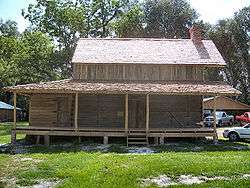Burnsed Blockhouse
The Burnsed Blockhouse (also known as the Carl Brown House) is a historic site originally located north of Sanderson, Florida, United States, off Jacksonville Road. On May 7, 1973, it was added to the U.S. National Register of Historic Places. The blockhouse, probably the oldest structure in Baker County, was later moved from Sanderson to Heritage Park in Macclenny.[4]
Burnsed Blockhouse | |
 The restored Burnsed Blockhouse, in Heritage Park | |
  | |
| Location | Macclenny, Florida |
|---|---|
| Coordinates | 30°16′45″N 82°8′0″W |
| Built | 1837[1] |
| Architectural style | Frame Vernacular[2] |
| NRHP reference No. | 73000567 |
| Added to NRHP | 7 May 1973[3] |
The only example of its distinctive design in Florida, the structure was built by settler James Burnsed (1817–1885) in 1837 by order of President Andrew Jackson,[5] probably as a non-military defense to protect settlers from Seminole raiding parties, whose movements along the St. Marys River could be observed from the site. Burnsed used it as a residence for his family as well.
The blockhouse was constructed with fine craftsmanship, as indicated by the precision fit of the squared hewn logs and their full-dovetail joinery. Burnsed supposedly stood on his head at the roof ridge of the building after its completion. The structure was built entirely of local yellow pine, and had openings from which to fire rifles.[1] Some of the logs were partly cut through to create knock-out sections to serve as gun ports, but they were never knocked out for use.[6] Holes were also drilled into them to accommodate dowels for weaving the warp of hand-woven cloth.[7]
The structure was supported by trapezoidal wooden piers resting on sleepers.[7] All boards were laid flush horizontally, and the corner joints are full dovetail. The doors are batten style, with two on the front of the house leading onto a porch, which has a pent roof. The windows were placed high in the walls of the original portion of the building and consist of square or long rectangular openings with hinged board single shutters. The house is two stories high; only the lower storey was lived in. The back porch connects the dining area with the kitchen in an outbuilding in the rear.[1]
Legal records on file in Baker County indicate that the property passed through the ownership of five families successively after it was deeded by the State of Florida in 1863. Legal documentation prior to this date is unavailable. The house is also known as the Carl Brown House because it was occupied by the Hugh and G. Carl Brown families from c. 1881 to 1950; Carl Brown's family were its last occupants.[6] Restoration was begun by the Durable Restoration Company of Columbus, Ohio in January 2007.[8]
References
- Greer, Diane D.; Evans, Mary K. (8 September 1971). "National Register of Historic Places Inventory/Nomination: or Registration: Burnsed Blockhouse". National Park Service. Retrieved 25 October 2019. with photos
- "Baker County". Florida's History Through Its Places. Florida's Office of Cultural and Historical Programs. 2007-11-04. Archived from the original on 2007-02-16. Retrieved 2006-09-05.
- "National Register Information System – Burnsed Blockhouse (#73000567)". National Register of Historic Places. National Park Service. 2 November 2013.
- "Community Budget Issue Requests - Tracking Id #1831 Burnsed Blockhouse Restoration". Archived from the original on December 14, 2004.
- Taylor, George (1 January 2009). "Burnsed Blockhouse, Macclenny, FL". Historical Architecture Main Gallery. University of North Florida. Archived from the original on 15 April 2018. Retrieved 25 October 2019.
- "Burnsed Blockhouse, Near St. Mary's River, Macclenny, Baker County, FL". Historic American Buildings Survey. Library of Congress.
- Reeves, F. Blair (1989). "A Guide to Florida's Historic Architecture". ufdc.ufl.edu. Gainesville, FL: University of Florida Press. Retrieved 26 October 2019.
- Dowling, Jean (January 2007). "Restoration has begun on the Burnsed Block House". durablerestorations.com. Archived from the original on 2007-09-21. Retrieved 2009-02-28.
External links

- Historic American Buildings Survey (HABS) No. FL-399, "Burnsed Blockhouse, Near St. Mary's River, Macclenny vicinity, Baker County, FL", 15 measured drawings